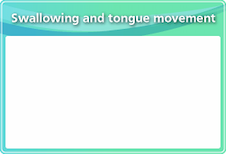Oral Function for Feeding
Feeding and swallowing can be classified into five stages. In these process the tongue plays an important role, assisting in mastication, gustatory sensation, including salivation, bolus formation, and propelling the bolus into the pharynx.
1. Primary stage
It refers to the time to decide what to eat and
the pace to eat. This stage is sometimes called as
“cognitive period.” as such decisions are
important. It refers to a series of actions from
finding food, seeing it, smelling it, determining
whether it can be eaten by the five senses,
carrying it to the mouth, and taking it in with the lips.
the pace to eat. This stage is sometimes called as
“cognitive period.” as such decisions are
important. It refers to a series of actions from
finding food, seeing it, smelling it, determining
whether it can be eaten by the five senses,
carrying it to the mouth, and taking it in with the lips.

2. Preparation stage
It refers to the time when the food taken into
the oral cavity is masticated to form a bolus.
The tongue presses the delivered food against
the palate and quickly examines the properties
of the food, such as hardness and temperature.
the oral cavity is masticated to form a bolus.
The tongue presses the delivered food against
the palate and quickly examines the properties
of the food, such as hardness and temperature.

3. Oral stage
It refers to the time when the bolus is
delivered from the oral cavity to the
pharynx by tongue movement.After the
oral stage, all exercises are reflexive.
delivered from the oral cavity to the
pharynx by tongue movement.After the
oral stage, all exercises are reflexive.

At this time, the lips are closed and the upper and lower teeth
are close to each other.The anterior two-thirds of the tongue
rises toward the base of the maxillary anterior teeth and the
anterior part of the hard palate.
are close to each other.The anterior two-thirds of the tongue
rises toward the base of the maxillary anterior teeth and the
anterior part of the hard palate.
4. Pharyngeal stage
It refers to the time when the bolus
passes through the pharynx due to the
very fast movement within 0.5 seconds
by the swallowing reflex.During the
pharyngeal phase, various muscle
movements occur simultaneously,
forming a series of movements that
push the bolus into the esophagus
without accidentally accepting it into
the airways.
passes through the pharynx due to the
very fast movement within 0.5 seconds
by the swallowing reflex.During the
pharyngeal phase, various muscle
movements occur simultaneously,
forming a series of movements that
push the bolus into the esophagus
without accidentally accepting it into
the airways.

5. Esophagus stage
It refers to the time when the bolus is
sent to the stomach by the peristaltic
movement of the esophagus.As the
bolus passes through the upper
esophageal sphincter, the muscles
reflexively relax and the bolus is
carried to the stomach at a rate of 4
cm per second.
sent to the stomach by the peristaltic
movement of the esophagus.As the
bolus passes through the upper
esophageal sphincter, the muscles
reflexively relax and the bolus is
carried to the stomach at a rate of 4
cm per second.







